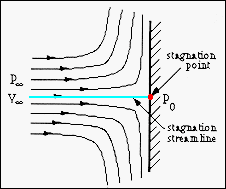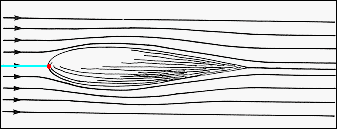|
|||||||||||||||||||
Mechanics |
|||||||||||||||||||
|
|
|
|||||||||||||||||
The top
diagram shows the streamlines associated with a non-viscous (inviscid) flow
interacting with a flat plate normal to its initial direction. A long way
from the plate (to the left in the diagram) the flow velocity is Voo and
the pressure is poo. As the flow approaches the plate its
velocity changes and the Bernoulli equation indicates that this will be associated
with pressure changes. Along the centerline, the stagnation streamline,
the flow velocity decreases to zero at the stagnation point - the point of
intersection of the streamline and the surface. At this point the pressure is
p0, the stagnation pressure of the flow. This streamline separates
the flow into two regions, the top fluid being deflected 'up' and the bottom
fluid being deflected 'down.' |
|||||||||||||||||||
 |
|||||||||||||||||||
From:
Smits, |
|||||||||||||||||||
The same flow behavior is seen for the streamline shape of the lower diagram. There is a stagnation streamline and a stagnation point at the symmetry point of the body and the flow separates at this line to move either above or below the body. The symmetric shape shown increases the flow velocity by equal amounts above and below the stagnation streamline and the pressure of the flow is therefore decreased by the same amount. A symmetric wing of this shape and with a zero angle of attack to the flow would give no lift and has no drag! |
|||||||||||||||||||
 |
|||||||||||||||||||
From:
Wegener, |
|||||||||||||||||||